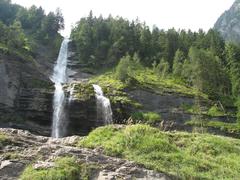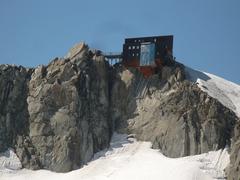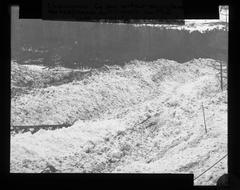
Aiguille du Midi Visiting Hours, Tickets, and Travel Guide: Chamonix Historical Sites
Date: 03/07/2025
Introduction
The Aiguille du Midi stands as a crown jewel of the Alps, soaring to 3,842 meters above Chamonix-Mont-Blanc, France. Renowned for its panoramic views of the French, Swiss, and Italian Alps—including the iconic Mont Blanc massif—this site blends mountaineering heritage with modern engineering marvels. Since the opening of its record-breaking cable car in 1955, the Aiguille du Midi has provided unparalleled access to the high Alps, transforming adventure tourism and offering visitors a dramatic encounter with Europe’s mountain grandeur (Aiguille du Midi Official Site; Altitudetrekker).
This comprehensive guide details everything you need for a seamless visit: up-to-date visiting hours, ticket information, accessibility insights, main attractions, nearby historical sites, and crucial environmental considerations. Whether you’re an avid mountaineer, a family traveler, or a history enthusiast, you’ll find practical tips and responsible tourism advice to make the most of your Chamonix adventure.
Historical Background and Engineering Significance
Origins and Development
The Aiguille du Midi, or “Needle of the Midday,” has long been a beacon for mountaineers and pioneers. In the early 20th century, the dream of making the high Alps accessible to the public began to take shape, catalyzed by advances in engineering and a spirit of adventure. Delayed by world wars and technical obstacles, the vision finally materialized with the construction of the cable car between 1951 and 1955.
The Cable Car: A Feat of Engineering
Engineered by Pierre Forestier, the Aiguille du Midi cable car was the world’s highest vertical ascent at its inauguration. It carries visitors from Chamonix (1,035 m) to the upper station (3,777 m) in just 20 minutes, overcoming formidable challenges such as harsh weather and minimal support structures (Aiguille du Midi Official Site). The system’s innovative design and construction techniques—including aerial logistics and hand-carved granite tunnels—are still celebrated today.
Modernization and Expansion
Upgrades over the decades have added features like the Panoramic Mont Blanc gondola linking France and Italy, the “Step into the Void” glass skywalk, and enhanced safety and environmental measures.
Visiting the Aiguille du Midi: Practical Information
Location and Getting There
- Address: 100 Place de l’Aiguille du Midi, 74400 Chamonix-Mont-Blanc, France (GPS: 45.881312, 6.891537)
- Access: A short walk from Chamonix’s center, with ample public transport links and paid parking nearby (Avygeo). Eco-friendly buses and free shuttles are available for ski pass holders (Mont Blanc Natural Resort).
Cable Car Operations and Visiting Hours
- Summer (June–September): 07:10 – 17:30
- Winter (December–March): 08:10 – 16:30
- Shoulder Seasons: 08:10 – 16:00
- Annual Maintenance: Closed each November; always check the official timetable before your visit.
Ticketing
- Pricing: Adult round-trips start at about €88 (seasonal and age variations apply; discounts for children, seniors, groups, and Mont Blanc MultiPass holders) (Avygeo; Traveler Bibles).
- Booking: Advance online booking is highly recommended for peak periods.
- Collection: Use automatic “Pick-Up Box” terminals at the departure station. Bring ID for verification.
Accessibility and Health
- Elevators and ramps provide access to main viewing platforms, galleries, and exhibitions, though some high-alpine routes (such as the arête) are only for experienced climbers (Avygeo).
- Wheelchair users can access most facilities; strollers are discouraged.
- Altitude precautions: At nearly 4,000 meters, the air is thin and cold year-round. Consult a doctor if you have heart, respiratory, or pregnancy concerns. Children under 3 are not advised to ascend.
Main Attractions and Visitor Experiences
The Aiguille du Midi Cable Car
- Journey: Two segments—Chamonix to Plan de l’Aiguille (2,317 m), then to the upper station (3,777 m), followed by an elevator to the summit terrace (3,842 m).
- Views: Panoramic cabins showcase the Chamonix valley, glaciers, and surrounding peaks.
Summit Terraces & Viewing Platforms
- 360-degree vistas include Mont Blanc, the Matterhorn, and Monte Rosa. Temperatures can be below freezing even in summer, so dress warmly.
“Step into the Void” Glass Skywalk
- Experience: Step into a glass box suspended over a 1,000-meter drop, with Mont Blanc as the backdrop—an unforgettable photo spot (Avygeo).
Le Tube: Circular Walkway
- Opened 2016: An enclosed passage looping around the summit, with interpretive panels on geology, history, and climbing heritage.
Panoramic Mont Blanc Gondola to Pointe Helbronner (Italy)
- Seasonal (June–September): Crosses the Vallée Blanche glacier to Pointe Helbronner (3,462 m), offering a unique cross-border experience and access to Courmayeur via the Skyway Monte Bianco.
Dining and Refreshments
- Le 3842 restaurant: Gourmet dining with extraordinary views (reservations recommended).
- Cafés, snack bars, and shops at both stations.
Mountaineering and Skiing
- Starting point for legendary routes such as the Vallée Blanche and the Mont Blanc ascent. Only for experienced alpinists—hire guides for safety.
Museum and Interpretive Exhibits
- Summit museum: Interactive displays on mountaineering history and the cable car’s construction.
Facilities and Services
- Observation decks and terraces
- Indoor galleries and exhibitions
- Restaurants and cafés
- Gift shops
- Free Wi-Fi and audio guide app
- First aid station
- Restrooms at base and summit
Nearby Attractions in Chamonix
- Montenvers Railway & Mer de Glace: Scenic train to glacier and ice cave.
- Chamonix Town Centre: Historic architecture, museums, and alpine culture.
- Brevent/Flegere Cable Cars: More viewpoints and hiking access.
Best Times to Visit & Weather
- Summer: Warmest, busiest, best for hiking and clear views; book early (Traveler Bibles).
- Winter: Snow-covered scenery, world-class skiing, and mountaineering.
- Shoulder seasons: Fewer crowds, some activities limited.
- Weather: Rapidly changing—bring layers, windproof clothing, sunglasses, and sunscreen (Where and When).
Environmental and Cultural Considerations
Environmental Impact
The cable car’s construction and continued operation have altered landscapes and increased human presence in a sensitive alpine ecosystem (Yoalin). Modern upgrades focus on reducing visual and physical impacts, replacing obsolete infrastructure, and using energy-efficient systems (Chamonix Official).
Climate Change and Glacial Retreat
Glacial retreat and increased rockfalls are visible consequences of a 2°C rise in temperatures since 1850 (Chamonix Guides; Metro UK). Educational centers and guided tours raise awareness and promote responsible tourism.
Sustainable Tourism
Visitor travel accounts for the majority of Chamonix Valley’s carbon footprint (Chamonix Guides). Use public transport, stick to marked paths, and respect wildlife (Northabroad).
Conservation and Protected Areas
Over 90% of the Chamonix Valley is protected, with active research and conservation partnerships (Chamonix Official).
Cultural Heritage
The Aiguille du Midi democratized high-altitude adventures, housing the world’s highest museum and honoring legends like Gaston Rébuffat (F4 Photography Gallery; Chamonix Official).
Accessibility and Inclusivity
Elevator access is available to most viewing platforms and the “Step into the Void” skywalk, though some terrain remains challenging (Anna Everywhere).
Travel Tips
- Arrive early for clearer skies and fewer crowds.
- Dress in layers; summit conditions are cold and windy.
- Bring sunglasses and sunscreen for high-altitude UV exposure.
- Stay hydrated and bring snacks.
- Check real-time weather and operating hours online.
- Use public transport for reduced environmental impact.
Frequently Asked Questions (FAQ)
Q: What are the visiting hours?
A: Hours vary by season; generally 07:10–17:30 in summer and 08:10–16:30 in winter. Confirm on the official website.
Q: How do I purchase tickets?
A: Book online in advance or at the station. Use Pick-Up Box terminals for online orders.
Q: Is the site accessible for people with disabilities?
A: Most areas are accessible; contact the operator for support.
Q: What should I wear?
A: Warm, windproof layers, sturdy shoes, gloves, sunglasses, and sunscreen.
Q: Are pets allowed?
A: No, animals are not permitted on the cable car.
Q: Are guided tours available?
A: Yes, including mountaineering, hiking, and photography excursions.
Conclusion and Call to Action
The Aiguille du Midi offers an unparalleled blend of alpine beauty, history, and adventure. Planning ahead—booking tickets, checking operating hours, and preparing for altitude—ensures a safe and rewarding experience. Embrace responsible tourism to help protect this fragile environment for future generations.
For the latest updates, ticketing options, and exclusive content, download the Mont Blanc Natural Resort app. Follow official social media channels and explore related articles on Chamonix’s historical and natural wonders.





